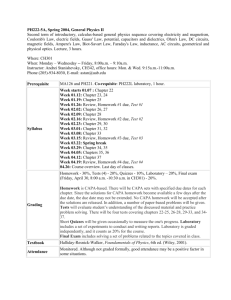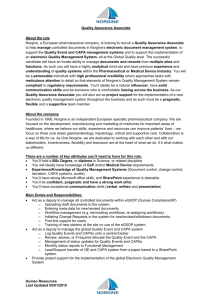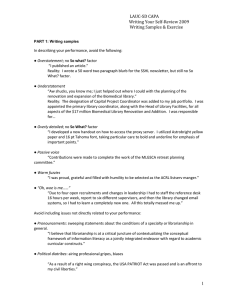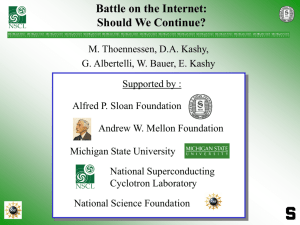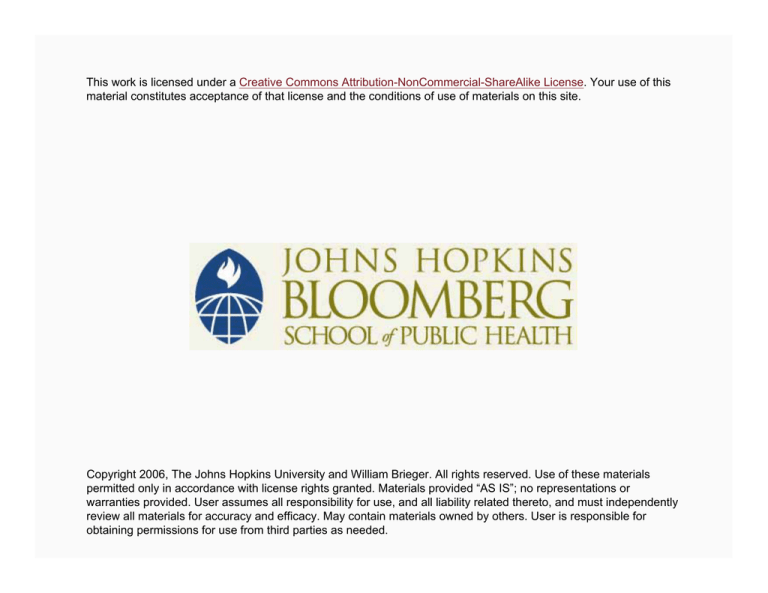
This work is licensed under a Creative Commons Attribution-NonCommercial-ShareAlike License. Your use of this
material constitutes acceptance of that license and the conditions of use of materials on this site.
Copyright 2006, The Johns Hopkins University and William Brieger. All rights reserved. Use of these materials
permitted only in accordance with license rights granted. Materials provided “AS IS”; no representations or
warranties provided. User assumes all responsibility for use, and all liability related thereto, and must independently
review all materials for accuracy and efficacy. May contain materials owned by others. User is responsible for
obtaining permissions for use from third parties as needed.
Replication of Training Designs
William Brieger, MPH, CHES, DrPH
Johns Hopkins University
Section A
Fidelity of a Training Design
Overview of Lecture 15
In the preceding lectures and assignments we have
worked on developing, implementing, and evaluating
training curricula and guides
We recognize that our training guides, once field
tested, can be used in other settings
This lecture addresses the issues surrounding “faithful”
replication of training designs in order to guarantee
comparable results
Continued
4
Overview of Lecture 15
We will accomplish this by . . .
− Examining the concept of “fidelity of
implementation”
− Reviewing a case study of Cascade Training in
Nigeria
− Listening to an interview on adapting training
materials in Guatemala
5
Why Replication?
Training may meet the need of a specific local
program, but . . .
Training is also a standard way of upgrading health
workers and other development staff across countries
and regions
Continued
6
Why Replication?
A good example is WHO’s Integrated Management of
Childhood Illness (IMCI)
− Basic treatment algorithms for pneumonia,
malaria, and diarrhea, for example, need to be
applied consistently
− A standard training guide is useful to ensure that
health workers treat these problems in a
consistent and safe manner (although differences
may exist in drug registration, resistance thus
requires adaptation)
7
The Challenge of Replication
“Surprisingly, many of the highest quality programs
fail to take adequate steps to monitor and verify
program integrity. This weakens the conclusions that
can be drawn regarding the program outcomes and
reduces the likelihood that replications will resemble
the original program”
− DHHS/SAMAHSA/CSAP 2002
Thus the need for fidelity:
− The extent to which delivery of a prevention
program conforms to the developer defined
parameters
− A recipe for replicating the program
X William Respress, Director of Research, Florida
Institute of Education
8
Aspects of Fidelity
Match or precision
Purity or integrity
Adherence or compliance
Prescription, exposure, and dosage
Quality implementation
Reinvention—deviates from program standard
9
Fidelity Enhances Validity
Preserves internal validity against
− Type I error—significant treatment effect, but this
arises because an unintended treatment
ingredient was added to the intervention
− Type II error—no treatment effect, but treatment
wasn’t actually administered as intended
Improves power (research efficiency) by reducing
unintended variability in treatment effect
Supports external validity by allowing replication,
dissemination
X Bonnie Spring, University of Illinois Chicago
10
Ensuring Fidelity
Writing implementation
(training) guide or manual
Training of trainers
Monitoring/observing
training implementation
−Was the training
delivered as intended?
−Did trainees respond
and comprehend as
expected?
Evaluating trainee
performance
11
Fidelity versus Adaptation
What are the core ingredients of the training design
needed to achieve the desired result?
− Training content
− Training methods
− Training context
What are the flexible aspects of the design that should
be considered for adaptation?
− Language and culture
− Literacy levels
− Human relations and communication norms
− Financial and logistical resources
12
A Case Study of Cascade Training from Nigeria
Photo: USAID, BASICS
Basic Support for
Institutionalizing Child
Survival (BASICS)
1994–1999 worked with
urban community based
coalitions of community
based organizations and
private health facilities
2000–2004 transferred
lessons on community
participation to enhancing
public sector primary care
services
13
Catchment Area Planning and Action (CAPA)
A community based
approach
Aim to strengthen
essential services at local
government primary
health care (PHC) facilities
within catchment areas
(CAs)
Through community
participation and
advocacy
−CAPA committees
Health worker training
Volunteer community
health promoters (CHPs)
14
Catchment Area Planning and Action
CAPA focused on primary level local government
health facilities in three Nigerian states
The aim was to involve community members in the
catchment area of each facility in dialogue with facility
staff
To improve the quality of care and increase access to
basic maternal and child health services such as . . .
− Antenatal care
− Immunization
− Prompt treatment of childhood illness
− Essential nutrition actions
Continued
15
Catchment Area Planning and Action
CAPA committees and trained volunteer community
health promoters
− Mobilized community interest and resources
− Conducted advocacy with local policy makers
16
CAPA Uses a Community-Based Approach
17
Catchment Area Structure
Community
Based
Organizations
Neighborhoods
and Settlements
CAPA
Committee
30
PHC
Facility
Staff
Community
Health
Promoters
10-40
18
Establishing a CAPAC
Advocacy
Pre-CAPA
CAPA Training
Post-CAPA
0
1
2
3
4
5
Weeks for Setting up a CAPA
19
CAPA Program Locations
State
Local
Governments
Catchment
Areas
Lagos
9
70
Kano
9
70
Abia
2
15
3
20
155
Cascade Training—
The Need for Replication at Each Level
20
More Information on CAPA
Additional information on the CAPA process is
available from BASICS
The CAPA Handbook can be found at . . .
− http://www.basics.org/publications/abs/abs_capat
ools_gen.html
An documentation assessment of CAPA
implementation can be obtained from . . .
− http://www.basics.org/publications/abs/abs_capa
2_gen.html
21
Section B
A Case Study of Cascade Training
Need for Cascade Training
To prepare community members for their new roles
as promoters, advocates, planners, and monitors in
the most expedient manner, CAPA adopted a cascade
training approach that rapidly transfers responsibility
from project staff to government master trainers and
to community members
Some training efforts are directed at improving the
knowledge and skill base of public and private
sector health providers
Continued
23
Need for Cascade Training
Some efforts are directed at building community
awareness of essential actions to preserve child
health
And some efforts are directed at building the
capacity for the organizational process necessary to
make community-based approaches succeed
24
Cascade Training Model in CAPA
25
State Level Training
The state level is the primary focus for quality control,
advocacy, providing services, and resources to support
CAPA, and receiving referrals
The state should provide master trainers to initiate and
coordinate the training at the LGA and catchment area
(community) levels
As such, it is essential that state-level participants be
well informed about child survival interventions, be
thoroughly grounded in the CAPA approach, and be
fully committed to community/health sector
partnerships
26
Content: Three Categories of Training
There are three general categories of training for
SMOH personnel in which project staff (with the help
of consultants) train groups of master trainers
− 1. Training Of Trainers (TOT) to improve technical
team skills and knowledge about key child
survival issues and interventions
(immunization, nutrition, malaria)
− 2. TOT to prepare state facilitators as
coordinators of the CAPA processes
− 3. TOT at local government level for facilitating
the training and performance of CAPA
committees in advocacy and mobilization
27
Second Round for the CHPs
The three phase training process with state teams
takes place again when it is time to train Community
Health Promoters (CHPs) in mobilization, home
visiting, and group education techniques around the
priority technical intervention areas
28
Training Modules
Area
Modules
Content
Routine Immunization
5
Target diseases, cold chain, service
delivery, communication, monitoring
Essential Nutrition
Actions
2
Breastfeeding, vitamin A, weaning
Malaria
1
Case management, treatment, bednets
CAPA Committees
3
Technical content, planning, and
advocacy processes
Community Health
Promoters
1
Using counseling cards for technical
content
29
State Facilitators Trained to Lead TOTs at LGA Level
Provide training on technical
issues and on training
communities for CAPA
Provide training on the use
of the integrated CAPA
modules
Provide training on the
implementation steps
Conduct orientation on
facilitation and teaching
skills
Define roles and
responsibilities of partners
(community, public sector,
and private sector)
30
State Level Participants
State immunization officer
State nutrition officer
State malaria officer
State monitoring and
evaluation officer
Three to four
representatives of multisectoral group
31
State Trains Local Government Facilitators
TASKS
Master trainers train
participants to improve
communication skills
Promote understanding of
the roles and responsibilities
of CHPs
Develop and adopt a
timetable for LGA trainings
Assign trainers to LGAs
32
LGA Team Participants
Community health officer
Immunization manager
Health educators
Nutrition officer
Monitoring and evaluation
officer
Environmental health officer
Other LGA sectors
− Community development
− Education
− Information
− Women’s affairs
− Agriculture
− Finance
33
CAPA Committee Training
PROCESS
Conducted by LGA team
30 Volunteers selected after
pre-CAPA visits
Three day workshop on
three essential technical
areas
Concurrently develop a
workplan
CAPAC members organize
election of own officers
Photo: USAID, BASICS
34
Sample CAPA Committee Training Participants
Ward political leaders
Local institutions (educ., agric.,
etc.)
Private health facilities
CBO leaders by type and
location
Patent medicine vendors assoc.
Parent Teacher Associations
Road transport employers and
employees
Ethnic groups, traditional
leaders
Farmers’ clubs
Local NGOs
Savings cooperatives
35
Community Health Promoters
Who is a CHP?
− A literate volunteer with a natural interest in
promoting child health and who is ready to offer
assistance to the community as a counselor,
adviser, and motivator
What is the objective of CHP training?
− To create a cadre of volunteers to convey key
household messages about protecting the health
of children, seeking care in a timely way, and
making wise choices when seeking assistance for
their children
This results in 20-30 unpaid volunteers per catchment
area
36
Community Health Promoter Training Agenda
The need for community health promoters in CAPA
Importance of immunization and immunization
schedule
Key practices for successful breast and complementary
feeding
Importance of vitamin A
Home management of malaria illness
How to counsel mothers/caregivers using counselling
cards and home health booklet
Field practice/discussion on field practice
Conducting group education
37
Cascade Training in Lagos State
3000
2500
2400
2300
CAPAC
CHP
2000
1500
1000
500
25
100
300
0
State Team LGA Team PHC Staff
38
Community Health Promoter Training
3000
2500
2787
2292
2000
Lagos
Kano
Abia
1438
1500
1071
1024
1000
491
500
232
0
Round 1
Refresher
Round 2
39
Time Commitment for Cascade Training
9
8
8
8
7
7
6
Days
6
5
4
3
3
2
2
1
0
TOT
PHC Staff
CAPAC and CHP for 70 Lagos CAs
CAPA
Facilitation
CAPAC
CHP
Facilitation
CHP
40
Section C
Ensuring Fidelity of Implementation
A Review of the Cascade
State
Facilitation
Teams
LGA
Facilitation
Teams
PHC Facility
Officers and
Staff
CAPA
Committee
Members
Community
Health
Promoters
42
BASICS Staff Efforts with the State-to-LGA Cascade
Development, printing, and distribution of all the
modules for training at all levels
BASICS staff fully facilitated all the state team training
and logistics
− BASICS transferred all needed skills to the state for
training the LGAs
BASICS staff backstopped some of the LGA team
training
− But supplied standard logistics to all LGA trainings
BASICS staff ensured QA in process planning, material
distribution, training content, and time management
at all levels—State-LGA-Community
43
Observations of State Facilitators
State teams worked with BASICS in developing the
modules
IEC materials training at the state was easier with them
than with the LGA staff
The state teams are experienced facilitators
− Worked with other agencies like UNICEF in polio,
etc.
− Easy for them to grasp the procedure, methods,
and content
Continued
44
Observations of State Facilitators
Although not all of them would go at the same speed,
on the whole they mastered the training challenges
almost immediately
The state teams were able to replicate everything in
part because BASICS guaranteed a supportive
enabling environment
45
Efforts to Ensure Fidelity from LGA to CA
BASICS staff made contact through phone/visit to the
LGA and wrote to remind the SMOH about each
training
BASICS staff (or consultants) were present at more
than 75% of all the LGA technical training—spot
checks
State team had been groomed to respond to both
technical and logistic needs at the LGA
Several state teams were created so the same training
could be implemented in different LGAs
simultaneously
Continued
46
Efforts to Ensure Fidelity from LGA to CA
BASICS staff served as back-up if state facilitators could
not observe
Ensured standard and quality logistical arrangements
from handouts to lunch
State teams had designated monitoring officers for
LGAs
47
Review Sessions with State Facilitators
Attendance levels
Reports of facilitation
problems
Content covered
Group work/dynamics
Implementation challenges
Logistics
Time management
Photo: USAID, BASICS
48
Examples of Review of LGA TOT Implementation
Photo: USAID, BASICS
Participants displayed high
degree of seriousness,
commitment, and maturity
Participants showed that
they have acquired enough
knowledge and skills
necessary to train the CHPs
in the various catchment
areas
The state facilitators lived up
to expectation and were very
committed
49
Problems Observed
Photo: USAID, BASICS
Training generally started
late, due to the heavy traffic
and long distance between
office and training venue
This led to a spillover of the
agenda into the second day
The result was that some of
the topics for the second day
had to be rushed, while the
participants could not be
taken through the case
scenarios at the end of the
module
50
Sample Results from Malaria Training for PHC Staff
Mean Scores/Percentage
Lagos Mainland LGA
90
80
70
60
50
40
30
20
10
0
79
75
65
56
Pre-test
Post-test
Officers in Charge
Other Staff
51
Observer Feedback at CHP Trainings
Formal feedback opportunities were built into the
training and participants commented that . . .
− The sessions were participatory, with judicious use
of brain storming sessions, small group
discussions, role-playing, plenary sessions, and
demonstrations on net dipping
− The training went well in most of the PHCs—
participation and comprehension was highly
commendable
− Participants were happy to be part of the training
− They saw it as an eye opener and pointed out that
they have acquired the necessary skills needed to
give optimal care to the children
52
CHP Implementation Problems at the Catchment Area
Training was postponed a day because the officer in
charge at Ayagtuga did not mobilize participants due
to late notice about the training
Training was delayed a week because the acting OIC at
Coker, Aguda claimed the OIC did not brief her about
the upcoming training prior to going on leave
At Adeniji, Adele, participants complained the training
was taking them away from their businesses and work
for too long and many slipped away
Continued
53
CHP Implementation Problems at the Catchment Area
The hall designated for training at Baruwa was not
available the first day of training so the health officer
had to rent canopies while participants waited
Several LGAs experienced transfer of trained health
staff prior to CHP training
54
Addressing Special Skill Gaps
BASICS staff monitoring in the field discovered some
challenges to LGA facilitators
− Training approaches to illiterate CAPA committee
members and volunteer CHPs
Continued
55
Addressing Special Skill Gaps
BASICS staff monitoring in the field discovered some
challenges to LGA facilitators
− Training approaches to illiterate CAPA committee
members and volunteer CHPs
− Sensitive social and cultural issues, such as
perceived immunization safety
Continued
56
Addressing Special Skill Gaps
BASICS staff monitoring in the field discovered some
challenges to LGA facilitators
− Training approaches to illiterate CAPA committee
members and volunteer CHPs
− Sensitive social and cultural issues, such as
perceived immunization safety
− Technical content misconceptions, especially
among front line staff with minimal formal training
and education
57
Recommendations from Lagos Field Office
Review training modules to reduce content
− Combine nutrition and malaria technical modules
− Routine immunization module stand alone
(intense)
− Number of training days can then be reduced
Continued
58
Recommendations from Lagos Field Office
Review training modules to reduce content
− Combine nutrition and malaria technical modules
− Routine immunization module stand alone
(intense)
− Number of training days can then be reduced
Review efficiency of the existing LGA PHC structure
− Enhance capacity in 70 current CAs to conduct and
sustain initial training, refresher training, and
replacement training
− Identify additional CAs and plan training
− Expand to remaining 11 LGAs
Continued
59
Recommendations from Lagos Field Office
Review training modules to reduce content
− Combine nutrition and malaria technical modules
− Routine immunization module stand alone
(intense)
− Number of training days can then be reduced
Review efficiency of the existing LGA PHC structure
− Enhance capacity in 70 current CAs to conduct and
sustain initial training, refresher training, and
replacement training
− Identify additional CAs and plan training
− Expand to remaining 11 LGAs
Private sector health facility mobilization needed to
supplement government PHC
60


